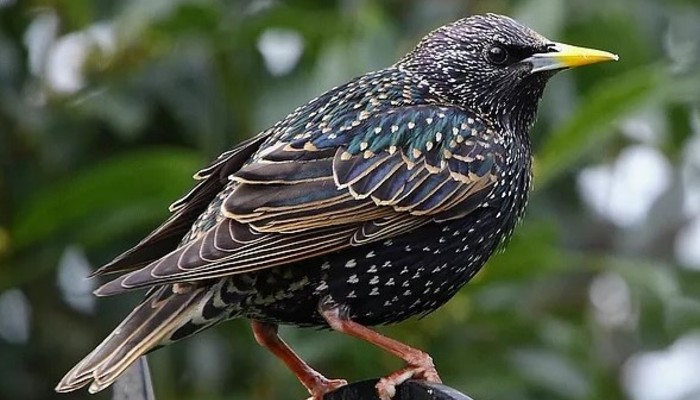The Starling and Me

The blinding glare of the April evening sun over the water obscures my ability to sort out details. I’m standing on our driveway, next to my vehicle, trying to figure out what is floating on the pond’s surface near the wood duck nesting box. I drive up to our house, go inside and look through a spotting scope to discover the floating substance is down feathers and wood chips. Confused, I swing the scope’s field of view to the opening of the wood duck house just in time to see a sharp yellow beak emerge stuffed with feathers and wood chips. “Oh no,” I groan.
The April morning twilight is cool and still. I hear a soft tap coming from inside a dead snag, or what I like to call, a wildlife tree. This particular wildlife tree has had red-headed woodpeckers nest in it for many years in a row. They’ve returned again this year; I smile. A call from a nearby location catches my attention. It’s immediately followed by two more similar calls, each from different locations. There are three of them. Alarmed, I scan the tree tops looking for visible confirmation.
Suddenly, a black form swoops down and lands at one of the woodpecker cavity openings on the wildlife tree. The occupant of the cavity, a red-headed woodpecker, bursts out of the hole confronting the invader before becoming entrapped in the cavity. The two birds entangle, squawking and screeching, wings fluttering wildly as each tries to gain the upper hand. Just as I think the redhead is getting the advantage over the starling, two more starlings swoop down on the redhead, forcing it to flee.
It’s not over yet. Another red-headed woodpecker, presumably the other’s mate, soars in, striking one of the starlings. The redhead is quickly attacked by the other two starlings. For a short while, the redhead takes on all three starlings, trying to place precise blows while avoiding the starling death grip (a talon into the eye socket). A fourth starling joins the battle forcing the redhead to flee.
The late-April morning breaks cold and white. It’s the second major snow storm we’ve had this month. Bundled up in winter clothing, I step out onto the covered porch and spot a tiny form of feathers hunkered down in a porch corner free from snow. It’s an Eastern phoebe, and she has one of her wings covering her head. I hear frantic chatter, and look up to see a second phoebe, likely her mate, scolding me as it flutters wildly up and down each time it tries to perch, and then slip, on the snow-covered railing.
For three years now, I have been removing European starlings, an invasive species, from the oak savanna area surrounding our house and barn. The results have been encouraging, with so many native birds successfully nesting again such as wood ducks, great crested flycatchers, and all the woodpecker species.
But the 2018 nesting season was different. As was the case in past years, I thought that I had thoroughly discouraged the starlings with my efforts in February, March, and early April. Things were going well, the phoebes had a nest built on the nesting platform we provided, both wood duck houses were occupied, and the wildlife trees near the pole barn were full of woodpecker species.
My optimism plummeted after the occurrence of the above events. Nonetheless, I doubled down, investing more resources into outwitting the clever starling in defense of my native bird neighbors.
For the native birds, it worked out mostly okay. The redheads left their favorite wildlife tree but nested nearby. For mother wood duck, I intervened before the starlings pierced her eggs. She recovered the eggs with more down feathers and raised a successful brood. The phoebe did not make it, but that was no fault of the starlings.
For me, however, the jury is still out. I was hoping that if I could prevent the starlings from nesting for a few years, their imprint to the area would disappear, freeing me the time and agony of using deadly force.
I leave our driveway and motor down a short distance to the highway intersection. Car idling at the stop, I spot roughly 300 starlings sitting on the power line next to a large dairy farm. It’s an incredible bird, I think. Beautiful iridescent plumage. Even the somewhat annoying yellow-daggered beak has character with the lower mandible turning pink in females and blue in males during the breeding season. They have a mastery of so many calls. And intelligence. I struggle to match wits with only a handful of starlings. No doubt the combined gritty intelligence of all these 300 birds far exceeds mine.
I can feel the weight of 600 eye balls on me. I slump a bit in the car seat as I read their thoughts – he is an enemy of our kind, an atypical human species.
We are not done with you yet!
Note to readers. For background to this blog, check out “Spring Without Starlings,” Aug. 9, 2016.
Originally published in Environmental Returns.
Tags: David Cordray, native species, starlings

